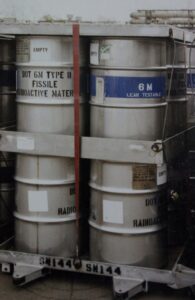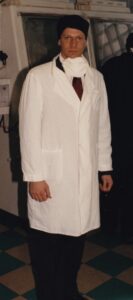ASTANA — Kazakhstan’s decision to renounce all weapons of mass destruction inherited from the Soviet Union was key to the 30 years of the country’s prosperity, peace, and security, said a top American expert in the field.

In an interview with The Astana Times, Andy Weber, a Senior Fellow at the Council on Strategic Risks, reflected on Kazakhstan’s pivotal decision to renounce weapons of mass destruction. Photo credit: The Astana Times
“It was the wisest decision possible,” said Andy Weber, a senior fellow at the Council on Strategic Risks’ Janne E. Nolan Center on Strategic Weapons, during an interview with The Astana Times.
With a career dedicated to countering nuclear, chemical, and biological threats, Weber’s extensive service to the United States government, including five-and-a-half years as the Assistant Secretary of Defense for Nuclear, Chemical, and Biological Defense Programs under President Barack Obama, underscores his authority on the matter. His responsibilities involved overseeing efforts like the removal of weapons-grade uranium from Kazakhstan and Georgia under the Nunn Lugar Cooperative Threat Reduction program and similar efforts elsewhere.
Project Sapphire: witnessing Kazakhstan’s first steps toward a nuclear weapon-free future
Weber personally witnessed Kazakhstan’s initial steps towards a future without nuclear arms. He recalled a top-secret operation known as Project Sapphire that took place in 1994 and involved safeguarding 600 kilograms of highly enriched uranium (HEU) in the eastern part of Kazakhstan to prevent any misuse by terrorist or criminal organizations. There was no established protocol for experts to handle such a large amount of HEU capable of producing more than twenty Hiroshima-sized bombs. Weber, who served as the first secretary at the newly established U.S. Embassy in Almaty, played a key role in that operation.
“It was an incredible historic experience. (…) It was the best several years of my life and career,” he said.
His story is worthy of any Hollywood biopic and, in fact, is featured in Netflix’s newest documentary, “Turning Point: The Bomb and the Cold War.” Recalling his early days in Kazakhstan back in the summer of 1993, Weber shared an intriguing encounter with his car mechanic, Slava, who offered him the opportunity to purchase uranium.
“It was a crazy time in history. There were a lot of scams going on at the time, and I was very skeptical, but I said, ‘Well, I’d like to learn more details.’”

A U.S. Air Force C-5 Galaxy sits on the tarmac of the Ust-Kamenogorsk airport in 1994 as it gets loaded with the HEU under Project Sapphire. Photo credit: MFA of Kazakhstan
Over several months, Weber developed a rapport with Vitaly Mette, the director of the Ulba Metallurgical Plant (UMP) in Ust-Kamenogorsk. The rapport took an unexpected turn when Mette shared sensitive information—information so shocking it could be likened to a bombshell.
During one of his trips in Almaty with Slava, Weber visited a sports and hunting store located in an apartment complex. There, he encountered Colonel Korbator, a former border guard from the KGB (Soviet Union’s Committee of State Security). Korbator suggested they take a walk. Weber recalled that during the walk, Korbator mentioned that Mette had a message for him. Colonel Korbator handed Weber a piece of paper folded in half.

HEU ready to be transported. Photo credit: MFA of Kazakhstan

Weber at Ust-Kamenogorsk during the first visit to Ulba Plant. Photo credit: MFA of Kazakhstan
“I casually glanced down at the paper. It said: ‘600 kg, U-235, 90%.’ I folded it back. I remember putting it in my pocket. I just thought, ‘Oh, my God, if this is true, that’s enough weapons-grade uranium for a couple of dozen nuclear bombs,’” Weber said.
Upon returning to the embassy that same day, Weber promptly shared this alarming revelation with Washington.
“Of course, there was a lot of skepticism that this was even possible. But eventually, it checked out,” he said.
The encounter with a former KGB officer and the subsequent message from Mette a few months later led to official discussions between Kazakh and U.S. presidents Nursultan Nazarbayev and Bill Clinton in Washington, D.C., in February 1994. During this meeting, negotiations took place regarding the permission for U.S. experts, including Weber, to inspect the level of uranium enrichment and quantity at the Ulba plant. The verification process confirmed the accuracy of Mette’s message delivered through Korbator.
“We did some analysis in the laboratory at the plant and confirmed the enrichment level… When we reported this back to Washington, the alarms went off. That’s when Washington went into high gear. We started a process of planning and negotiating with the government of Kazakhstan about this secret project to package it safely and transport it to the US,” Weber said.
According to Weber, the mission was kept in extreme secrecy due to concerns about potential interception by terrorists or criminal groups while transporting the material through Ust-Kamenogorsk.
“For the first time ever there was such a project where the material that could be used by a terrorist group or a rogue state, that would give them a shortcut to developing nuclear weapons, like the ones the US dropped on Japan to end World War II. This much material was a huge security threat to the region and the world,” Weber said.
Building trust through diplomacy
Weber emphasized that the successful completion of the unique project paved the way for numerous projects spanning decades aimed at identifying countries possessing nuclear materials suitable for weaponization, such as fissile materials like highly enriched uranium and, in some cases, plutonium. The focus was on securing these materials and either returning them to their country of origin, Russia, or occasionally sending them to the US. This was done to prevent any potential diversion and permanently eliminate their availability on the market as a part of nonproliferation efforts.

Weapons grade uranium is loaded on a USAF C-5 aircraft to be transported to the US. Photo credit: Ministry of Foreign Affairs of Kazakhstan
“President Obama started a series of Nuclear Security Summits. In 2012, he, President Nazarbayev and then Russia’s President [Dmitry] Medvedev announced another project that sort of grew out of this original project, Sapphire. It led to decades of close cooperation on non-proliferation, dismantling the world’s largest biological weapons factory in Stepnogorsk. It was another project that we did together with Kazakhstan. It was part of a global effort to reduce the risk of these horrific nuclear weapons, which haven’t been used for almost 75 years, and we hope that they will never be used,” Weber said.
He highlighted the relationships and trust that developed between the US and Kazakhstan, noting the crucial role played by officials and embassies from both countries in bringing the two nations together at the onset of their diplomatic ties.
“That ability to work together on a secret project, which was publicly announced after it was completed and the material was safely stored at Oak Ridge, Tennessee, brought our countries much, much closer together. And we built on that trust,” Weber said.
Weber also recalled the many successes of trilateral cooperation between the US, Kazakhstan and Russia, expressing sadness that such cooperation is impossible in current circumstances.
“There were so many accomplishments that were done together, including with Russia. The Nunn Lugar Cooperative Threat Reduction Program, which I spent much of my professional life working on. Most of the effort was in Russia,” he said.
Kazakhstan’s global initiative for biological safety
Recalling a pivotal moment in 1995, Weber shared an event where he was granted permission by the Kazakh government to undertake a clandestine visit to the largest biological weapons facility in the world. He revealed that President Kassym-Jomart Tokayev, who was then serving as Foreign Minister, played a direct role in that decision. Constructed by the Soviet Union during the 1980s following the adoption of the Biological Weapons Convention, this facility had the capability to produce 300 metric tons of anthrax within an eight-month wartime mobilization period.
Today, according to Weber, the site stands as a green field, a testament to a multi-year effort to dismantle the facility safely and environmentally responsibly, ensuring it can never again be utilized for nefarious purposes. This collaborative endeavor exemplifies the close cooperation achievable between nations. Furthermore, recent developments, including the establishment of the International Atomic Energy Agency’s fuel bank for low-enriched uranium at the Ulba plant, underscore Kazakhstan’s trusted status in non-proliferation efforts.
When asked about Kazakhstan’s initiative to establish an International Agency for Biological Safety (IABS), Weber expressed appreciation for the proposal, acknowledging the current lack of such an organization on a global scale. “It’s incredible, isn’t it?” Weber remarked, highlighting the existing Biological Weapons Convention’s implementation support unit, which he considered insufficient with its mere four personnel.
He lauded President Tokayev’s ambitious proposal, calling it a “brilliant initiative” amidst global challenges, including the recent pandemic and geopolitical tensions, including the Russia-Ukraine conflict.
Acknowledging the necessity for gradual progress and addressing funding concerns, Weber expressed confidence in the eventual realization of the IABS. He emphasized the significance of having a United Nations member state at the level of head of state championing such a groundbreaking concept on the international stage.
“I think it’s fantastic,” Weber concluded, underscoring the potential of Kazakhstan’s initiative to address critical global health and security challenges.

